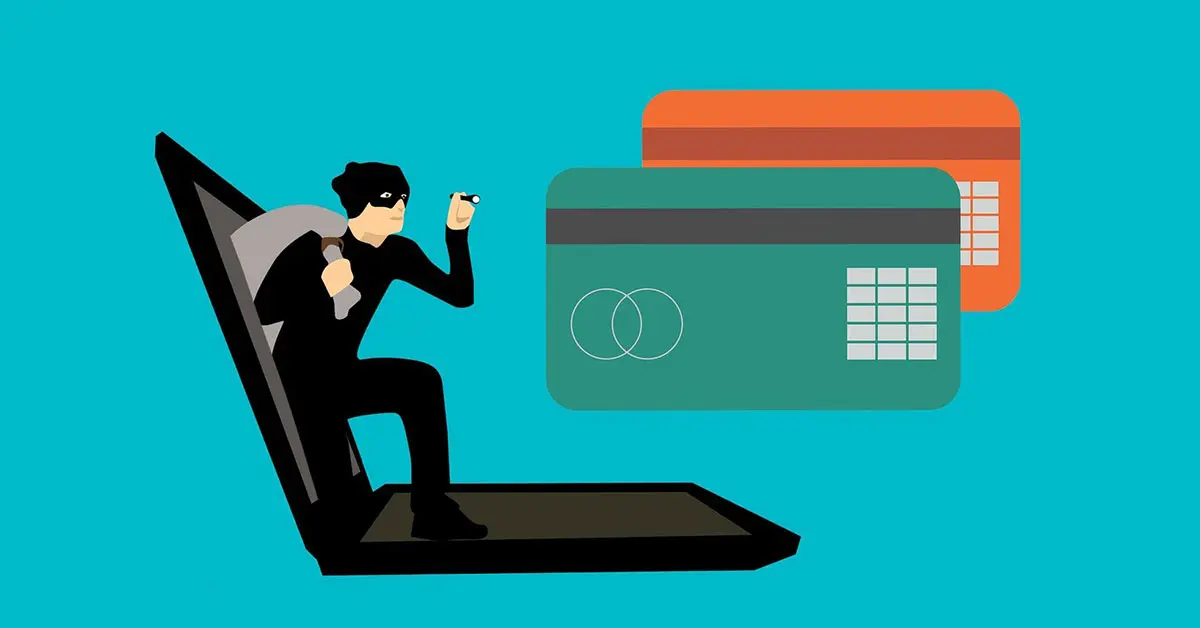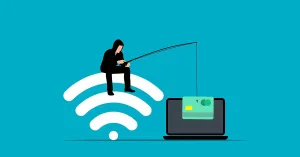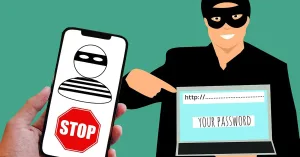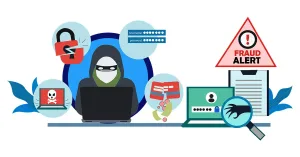Individuals fell victim to financial fraud every day before the world went digital. But, with losses to frauds and scams totaling $10 billion in 2023, it’s clear that technology and the internet have exacerbated the problem. Not only is it easier for fraudsters to reach out to victims and hide their identities online, but it’s also much harder to recover lost funds.
The best way to avoid becoming part of these statistics is to protect yourself when you go online or use devices like phones and laptops. But, if you’ve already fallen victim to a scam and had your money stolen, strong passwords and VPNs won't help much. So, what do you do if you suspect you’ve been a victim of financial fraud?
Since acting swiftly and decisively is essential to increasing the chances of retrieving lost funds, this article will detail everything you need to do in the aftermath of financial fraud. We’ll discuss why you should gather as much information as possible about the fraudster, how to report the fraud to the relevant authorities, and how you can prevent another fraud in the future.
What Constitutes Financial Fraud?
First, let’s take a general look at financial fraud. The Fraud Survey, commissioned by the Bureau of Justice Statistics, defines financial fraud as:
“Any attempt to intentionally and knowingly deceive the victim by misrepresenting, concealing, or omitting facts about promised goods, services, or other benefits and consequences that are nonexistent, unnecessary, never intended to be provided, or deliberately distorted for the purpose of monetary gain.”
Even if a fraudster is playing the long game and trying to gain your trust or gather information about your identity, the likeliest end goal of any scam is financial gain. This means that most fraud attempts, from impostor scams to fake lotteries, bogus investments, and scam shopping sites, could constitute financial fraud.
It doesn’t matter how the fraudster convinced you to hand over your hard-earned cash or how they demanded you get the money to them; if you’ve lost funds due to a scam, you’ve been a victim of financial fraud. Here’s what to do next…
STEP 1: Confirm Your Suspicions
If you notice a charge on your card that you can’t remember making, or you bought a gift for a family member from a shady website that still hasn’t arrived six months later, it’s natural to suspect fraud.
However, it’s important to confirm your suspicions before taking action. Sometimes, a charge may appear unfamiliar due to a delayed transaction or a legitimate merchant using a different name on billing statements.
To avoid unnecessary panic or confusion, follow these steps to confirm whether you’re dealing with fraud:
- Review your account statements thoroughly: Look through your recent transactions to check if the charge aligns with a purchase you forgot to make.
- Check for small or recurring charges: Often, fraudsters will start with small, seemingly insignificant charges to see if they go unnoticed. This is a warning sign that more substantial fraud is coming.
- Contact the merchant: If there’s a charge you don’t recognize, call the merchant directly to verify it. They may be able to provide additional details or clarify whether a transaction is suspicious. If you don’t receive a response, run the merchant’s name through a search engine with the words ‘fraud’ and ‘scam’.
- Ask others: If you share the account with someone else, such as a family member or colleague, check with them to see if they made the purchase or used the account.
Note down any information you gather during this step. Then, once you’re sure a transaction is fraudulent, it’s time to take action.
STEP 2: Notify Your Bank
Once you have identified unauthorized transactions or suspicious activity, the next step is to notify your financial institution as quickly as possible. This is crucial for stopping further losses and protecting your accounts.
- Contact your bank or card provider: Most financial institutions have 24/7 fraud hotlines, so call them immediately to report the issue. Offer as many details as you can about the suspicious transactions.
- Freeze or close compromised accounts: If the fraud affects your bank or credit accounts, request that the bank freeze the account to prevent additional fraudulent transactions. While moving money around can be a huge hassle, emptying the compromised account is a wise choice.
- Ask about fraud liability: You may not be held liable for unauthorized transactions if you report them promptly. While it can take a while, and an investigation may need to be conducted, you may be refunded the lost funds. However, different institutions have different policies, so ensure you take the time to talk to the bank’s fraud specialist to understand what protections are available.
- Obtain a new credit or debit card: If your card details were compromised, ask for a replacement card with a new account number. Most financial institutions will expedite this process in fraud cases.
Once you’ve completed this step, you can breathe a sigh of relief. But it’s important to follow through with the rest of the process, especially if your bank cannot recover lost funds, to ensure the fraud is fully dealt with.
STEP 3: Report the Fraud to the Authorities
Depending on the advice you receive from your bank, you may need to report the fraud to local law enforcement officials. Additionally, even if you managed to recover your stolen funds, you should report the fraud to the FTC and other relevant authorities so they can update their prevention and enforcement methods.
- File a police report: While the police may not have the resources to investigate every case, and it’s unlikely that the scammer will be caught, having an official report can be beneficial when working with financial institutions and credit bureaus.
- Report to the Federal Trade Commission (FTC): Use identitytheft.gov to report the exact details of the fraud. The FTC also enables you to create a recovery plan and forward your case to any other appropriate federal agencies.
- File a complaint with international consumer protection agencies: If you were abroad when a fraud occurred, or know that the fraudster is operating from a specific country, you’ll need to file a report with the domestic agencies.
STEP 4: Strengthen Your Security Measures
After reporting the issue to your bank or credit card provider, it’s time to secure your online presence. Cybercriminals often gain access to personal information through weak or compromised passwords, and strengthening your security measures can prevent further attacks.
- Change passwords on all affected accounts: You should habitually change the passwords to your online accounts. However, this is easier said than done. If fraudsters have gained access to any of your accounts, they might attempt to log into others, making this step essential.
- Use strong and unique passwords: Though it can make them harder to remember, avoid using the same password across multiple accounts. Using an encrypted password manager will make this process easier.
- Enable two-factor authentication (2FA): Two-factor authentication adds an extra layer of security to your accounts. In addition to entering a password, you’ll need to provide a second form of identification, such as a code sent to your email inbox. Again, though it adds a few minutes when logging into your accounts, it’s worth it.
- Update security questions: If any of your accounts use security questions, update these as well. If you’ve been a victim of identity theft as well as financial fraud, select more obscure questions than your mother’s maiden name or your pet’s name.
Completing this step will prevent future fraudulent charges on your cards and help protect you against scams.
STEP 5: Monitor Your Credit Report
Fraud, particularly identity theft, can have long-lasting effects on your financial well-being. This is especially true for your credit score, so check your credit report regularly following financial fraud.
- Request a copy of your credit report: You can get a free credit report from the largest credit reporting agencies, Equifax, Experian, and TransUnion, once a year. Go to AnnualCreditReport.com to get your free reports.
- Look for signs of ongoing fraud: As well as ensuring your credit score remains unaffected, your credit reports can show signs of further fraud attempts. Pay close attention to unfamiliar inquiries, new accounts, or loans taken out in your name.
- Consider a credit freeze: A credit freeze prevents potential creditors from accessing your credit report, meaning fraudsters can't open an account in your name, and legitimate requests are less likely to be denied on the basis of bad credit. The major credit bureaus all take credit freeze requests.
- Set up fraud alerts: A fraud alert lets potential lenders know that you've been a victim of fraud, which prompts them to take extra steps to verify your identity. Fraud alerts are free and, again, can be placed by contacting one of the major credit bureaus.
STEP 6. Keep Detailed Records of the Fraud and Your Actions
If your case requires further investigation to recover funds or bring the fraudster to justice, detailed records of what happened will be a huge help. Though it can prolong the stress associated with being a victim of financial fraud, try to keep a thorough record of your communications and actions during this time.
- Record unauthorized transactions: You should already have a list of the fraudulent transactions made to your account, including dates and amounts. If you need further proof, get back in touch with your bank and request any relevant documentation.
- Document all interactions: When you contact your bank, credit card provider, or any other institution, record the time, date, and names of the individuals you spoke with. Print out any email correspondence and keep a recording of the phone calls if the agency allows you to do so.
STEP 7: Work with a Fraud Specialist or Attorney
As mentioned, if your bank or a government agency is conducting an ongoing investigation into your fraud case, or if you fell victim to a particularly severe fraud, you may need professional help to resolve the situation and recover your losses.
- Hire an attorney specializing in financial fraud: If the financial losses are substantial or the fraud involves complex legal issues, consider hiring a lawyer specializing in fraud cases. They can help you recover stolen funds, sue for damages, and protect your rights.
- Seek advice from consumer protection organizations: Many consumer protection organizations offer free or low-cost legal advice and services for victims of fraud. In particular, the National Consumer Law Center (NCLC) provides valuable resources.
- Use your bank’s fraud investigation team: Most banks have specialized fraud teams that will work with you to investigate the fraud and, in many cases, reimburse unauthorized charges. Follow up with them regularly to ensure the investigation is moving forward.
STEP 8: Stay Vigilant
Fraudsters often keep your details or sell stolen information to other criminals. As a result, once you’ve been a victim of financial fraud, you’re more likely to be targeted again no matter what steps you take to resolve the issue. This is why it’s crucial to stay vigilant and monitor your financial accounts closely.
- Watch for phishing attempts: After experiencing fraud, you may be more likely to receive phishing emails, calls, or texts. Be wary of unsolicited communication asking for personal or financial information, and block suspicious senders.
- Explore identity theft protection: Identity theft protection services will monitor your accounts, alert you to suspicious activity, and even assist in recovering stolen information. While these services are not foolproof, and sometimes cost a significant amount of money, they can provide an added layer of protection.
In Conclusion…
Becoming a victim of financial fraud means that, on top of the anxiety and stress of losing your money, you may need to undertake a lengthy process to recover it. But, with a cool head and an organized to-do list, you can mitigate the damage and even help prevent others from becoming victims.
Remember, once you’ve been targeted, you’ll likely be subject to future fraud attempts. Take proactive steps to secure your accounts, monitor your credit, and protect your personal information, and you’ll be much more likely to avoid fraudsters.
Sources and Resources
- https://www.investopedia.com/financial-fraud-4689710
- https://ovc.ojp.gov/sites/g/files/xyckuh226/files/pubs/ID_theft/stepsforvictims.html
- https://www.cftc.gov/LearnAndProtect/AdvisoriesAndArticles/6Steps.html
- https://www.identityguard.com/news/what-to-do-if-you-are-a-victim-of-fraud
- https://www.aura.com/learn/fraud-victim-checklist
- https://www.usnews.com/banking/articles/how-banks-are-working-to-protect-you-from-fraud
- https://www.coursera.org/articles/fraud-analyst
- https://www.rocklandtrust.com/learning-center/business-resources/8-ways-to-protect-yourself-from-fraud





















Add comment